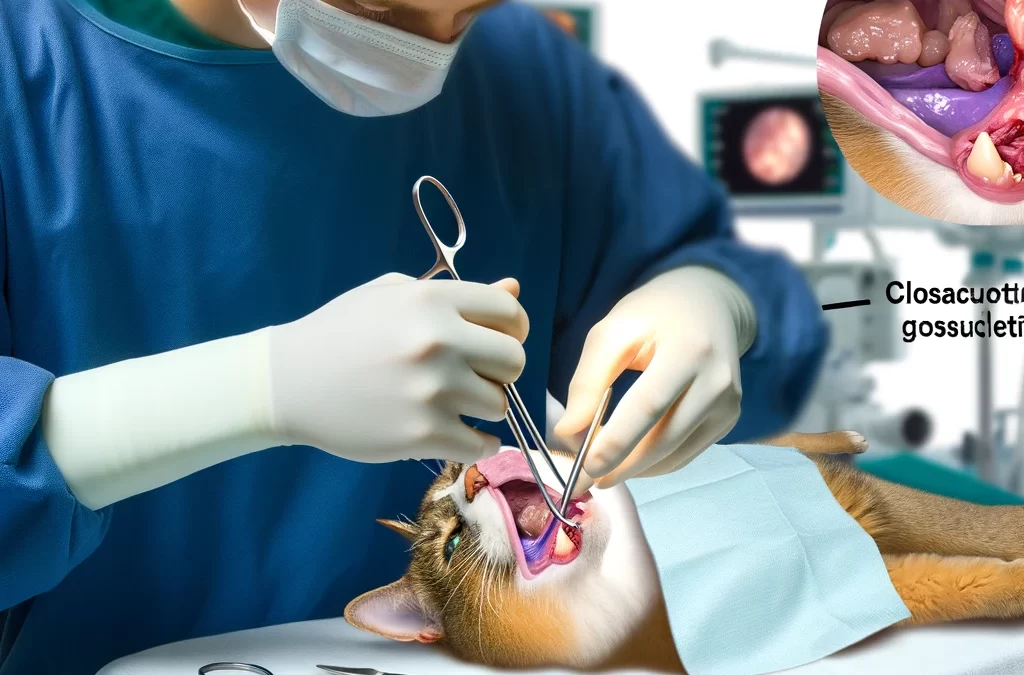
by TCMVET | Mar 16, 2024 | Cat Cancer & Tumors
Feline Oral Squamous Cell Carcinoma (FOSCC) is a prevalent form of cancer in cats, posing significant treatment challenges. Surgical intervention is a common treatment approach. This article explores the efficacy and limitations of surgical options for treating FOSCC, providing valuable insights for cat owners.
Understanding Feline Oral Squamous Cell Carcinoma FOSCC is a malignant tumor that affects the mouth of cats, characterized by its aggressive nature and rapid progression. Early detection and treatment are crucial for the best possible outcome.
Surgical Treatment of FOSCC Surgery is often considered the primary treatment method for FOSCC. The aim is to remove the tumor and surrounding tissues to achieve clean margins, thereby reducing the risk of recurrence.
Efficacy of Surgery
- Early-Stage FOSCC: Surgery is most effective when FOSCC is diagnosed at an early stage. Complete removal of the tumor can potentially cure the disease.
- Advanced FOSCC: In advanced stages, surgery can help alleviate symptoms and improve quality of life, but complete removal may not be possible.
Types of Surgical Procedures
- Mandibulectomy or Maxillectomy: Involves removing part of the jawbone, depending on the tumor’s location.
- Glossectomy: Partial or total removal of the tongue, used in cases where the tumor affects the tongue.
- Wide Local Excision: Removal of the tumor with a margin of healthy tissue, aiming to ensure all cancer cells are removed.
Limitations and Challenges
- Recurrence: Despite successful surgery, there’s a risk of recurrence, especially if the tumor margins are not clear.
- Post-Surgical Complications: Cats may face challenges eating or drinking post-surgery, and may require special care or feeding techniques.
- Quality of Life: Decisions about surgery must balance the potential benefits with the impact on the cat’s quality of life.
Advancements in Surgical Techniques Recent advancements in veterinary surgery, including laser surgery and cryosurgery, offer new possibilities for treating FOSCC with potentially fewer complications and better outcomes.
Surgical options for Feline Oral Squamous Cell Carcinoma offer hope but come with inherent challenges and limitations. Early detection remains key to successful treatment. Cat owners facing this diagnosis should discuss all possible options, including the potential outcomes and impacts on their pet’s quality of life, with their veterinarian.
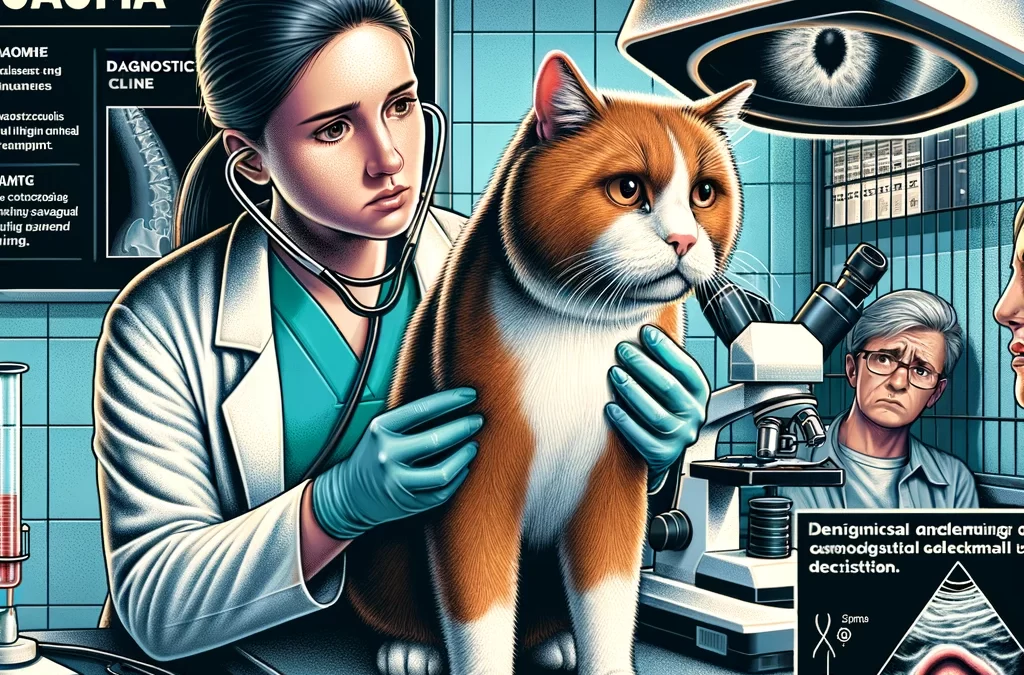
by TCMVET | Mar 16, 2024 | Cat Cancer & Tumors
Advanced Squamous Cell Carcinoma (SCC) in cats presents significant challenges in veterinary medicine. This article aims to shed light on these challenges, offering insights into the complexities of treating this aggressive form of cancer in felines.
Understanding Advanced Squamous Cell Carcinoma in Cats SCC is a type of malignant tumor that originates in the squamous cells, most commonly affecting the skin, mouth, and nose of cats. Advanced SCC refers to stages where the cancer has progressed significantly, often involving metastasis or extensive local invasion.
Challenges in Treatment
- Late Diagnosis: One of the primary challenges in treating advanced SCC in cats is its late diagnosis. Often, symptoms are subtle and go unnoticed until the cancer is in its advanced stages.
- Aggressive Nature: SCC is known for its aggressive growth and potential to spread (metastasize) to other body parts, complicating treatment options.
- Treatment Efficacy: Traditional treatments like surgery, chemotherapy, and radiation therapy, while effective in early stages, have limited success in advanced cases.
- Quality of Life Concerns: Maintaining the quality of life is a significant concern. Treatments can be invasive or discomforting, making it crucial to balance between managing the disease and ensuring the cat’s well-being.
- Cost of Treatment: The cost of treating advanced SCC can be prohibitive for many pet owners, limiting access to comprehensive care.
Innovative Treatment Approaches Recent advances in veterinary medicine have introduced new treatments for SCC. These include targeted therapies, immunotherapies, and novel drug combinations, which may offer new hope in managing advanced stages.
Supportive Care and Palliative Options In cases where treatment is not feasible, palliative care becomes a priority. This includes pain management, nutritional support, and other interventions to improve the quality of life for cats with advanced SCC.
Prevention and Early Detection Preventing SCC, particularly through minimizing exposure to risk factors like sunlight and tobacco smoke, and early detection through regular veterinary check-ups, are crucial in reducing the incidence of advanced SCC.
Treating advanced Squamous Cell Carcinoma in cats is fraught with challenges, from late diagnosis to the complexities of effective treatment. Advances in veterinary medicine are providing new avenues for care, but the focus should also be on prevention and early detection. For cat owners, understanding these challenges is key to providing the best possible care for their pets.
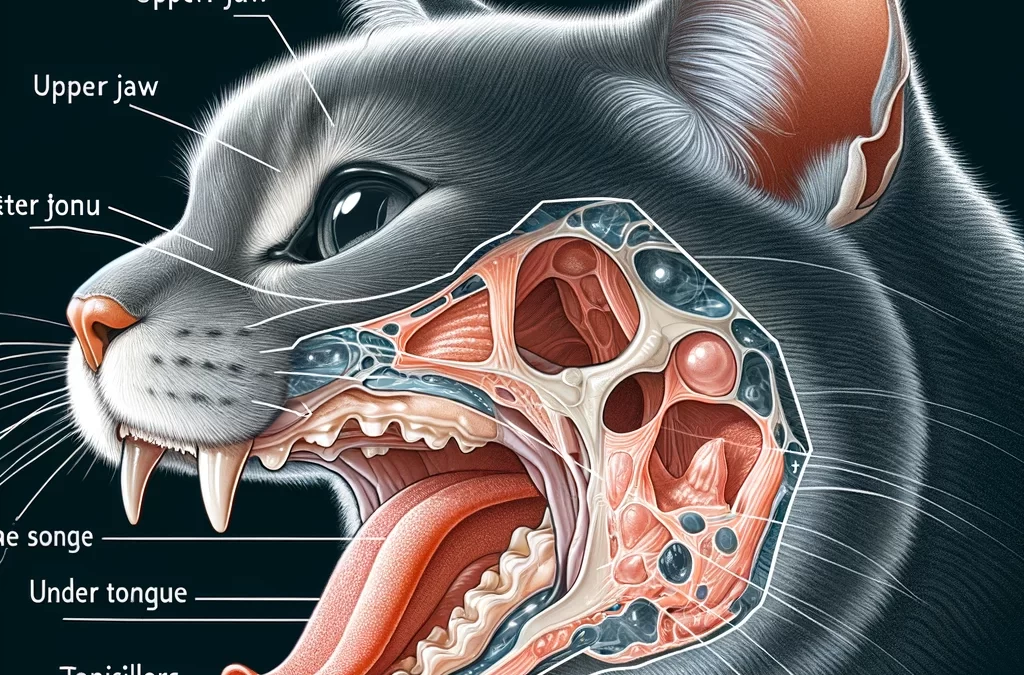
by TCMVET | Mar 16, 2024 | Cat Cancer & Tumors
Feline Squamous Cell Carcinoma (FSCC) is a significant health issue for cats, being the most prevalent oral tumor in felines. This comprehensive guide offers insights into the nature of FSCC, exploring its causes, symptoms, diagnosis, treatment, and preventative measures, providing cat owners with crucial information for managing this condition.
What is Feline Squamous Cell Carcinoma? FSCC is a malignant tumor that primarily affects the mouth and surrounding areas of cats. It originates in the squamous cells, which are thin, flat cells found in the tissue that lines the mouth. Known for its aggressive growth, FSCC can spread quickly if left untreated.
Causes and Risk Factors The exact cause of FSCC in cats is not fully understood, but several factors are believed to increase risk. Older cats are more commonly affected, with most diagnoses occurring in cats over the age of 10. Environmental factors like exposure to tobacco smoke or prolonged sun exposure may also play a role. Some research suggests a possible link to papillomavirus.
Symptoms and Early Detection Early signs of FSCC can be subtle and include difficulty eating, drooling, bad breath, and visible lumps or ulcers in the mouth. Since these symptoms can easily be mistaken for less serious dental issues, it’s important for cat owners to consult a veterinarian if they notice any persistent changes in their cat’s oral health.
Diagnosis and Staging Diagnosing FSCC typically involves a biopsy of the affected tissue. Imaging tests such as X-rays, CT scans, or MRIs may be used to determine the stage of the cancer, which is crucial for developing an effective treatment plan and understanding the prognosis.
Treatment Options Treatment varies depending on the stage of the cancer and the overall health of the cat. Surgery to remove the tumor is common in early stages. In more advanced cases, a combination of surgery, radiation therapy, and chemotherapy may be recommended. The goal is to manage the disease while maintaining the best possible quality of life for the cat.
Prognosis and Quality of Life The prognosis for cats with FSCC varies significantly. Early detection and treatment generally lead to a better outcome. Pain management and maintaining a comfortable environment are important for cats undergoing treatment for FSCC.
Prevention and Awareness Reducing exposure to risk factors like tobacco smoke and sunlight can help prevent FSCC. Regular veterinary check-ups are essential, especially for older cats. Being aware of the symptoms of FSCC and seeking early veterinary advice can lead to prompt treatment, significantly improving the prognosis.
Feline Squamous Cell Carcinoma is a serious condition that requires prompt attention. Awareness of its symptoms, regular veterinary check-ups, and understanding the available treatment options are key to managing this common oral tumor in cats. By staying informed and proactive, cat owners can play a crucial role in ensuring the health and well-being of their feline friends.
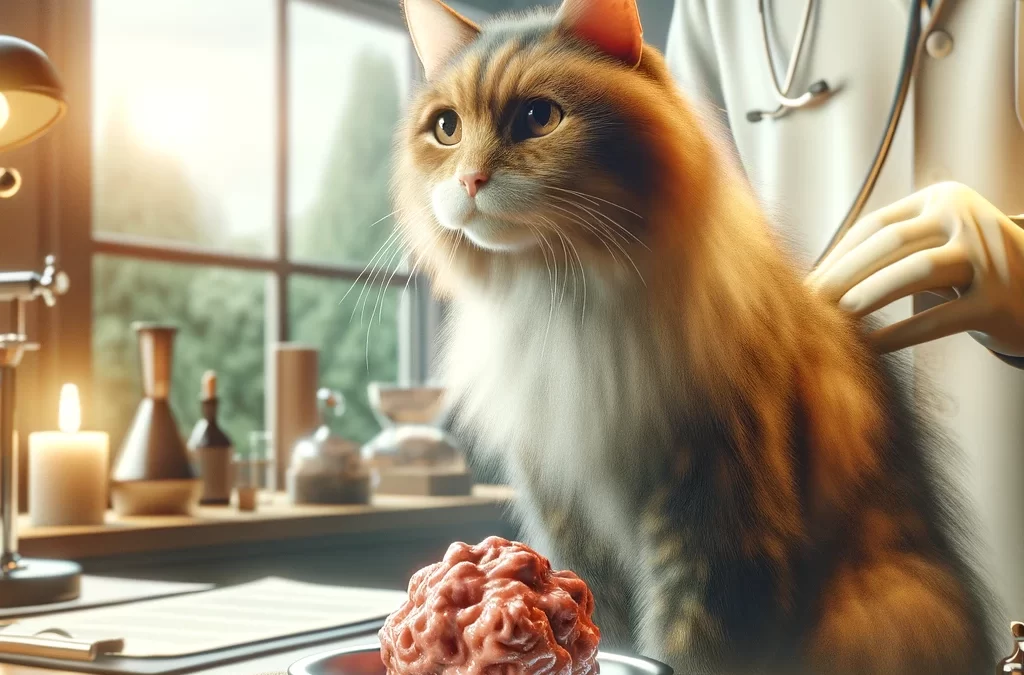
by TCMVET | Mar 12, 2024 | Cat Cancer & Tumors
Fibrosarcomas, a form of aggressive cancer in cats, can be a distressing diagnosis for any pet owner. Understanding the prognosis and managing the condition long-term are crucial aspects of care. This article aims to provide a detailed insight into these areas, offering guidance and hope for cat owners.
Understanding Fibrosarcomas in Cats Fibrosarcomas in cats are malignant tumors that originate from fibrous connective tissue. They can occur anywhere in the body but are most commonly found on the skin or beneath it. The aggressive nature of these tumors often means they are invasive and can recur after treatment.
Factors Influencing Prognosis The prognosis for a cat with fibrosarcoma depends on several factors:
- Location and Size of the Tumor: Tumors in certain locations or of significant size can be more challenging to treat effectively.
- Stage of Cancer: Early-stage cancers have a better prognosis.
- Response to Treatment: How well the tumor responds to initial treatment (surgery, chemotherapy, or radiation) can indicate long-term outcomes.
Treatment and Its Impact on Prognosis Treatment typically involves surgical removal of the tumor, possibly followed by radiation therapy or chemotherapy. The success of these treatments in completely removing or reducing the cancer significantly impacts the prognosis.
Long-Term Management Strategies
- Regular Veterinary Check-ups: Monitoring for recurrence or spread of the cancer is vital.
- Nutrition and Diet: A nutritious diet tailored to support a cat’s immune system can aid in recovery and overall health.
- Pain Management: Effective pain management strategies are important for maintaining quality of life.
- Supportive Care: Providing a comfortable and stress-free environment is essential for a cat’s wellbeing.
The Role of Palliative Care In cases where curative treatment is not an option, palliative care focuses on providing the best possible quality of life, managing symptoms, and ensuring comfort.
While the diagnosis of fibrosarcoma in cats can be daunting, understanding the prognosis and implementing a robust long-term management plan can significantly improve a cat’s quality of life. Advances in veterinary medicine continue to enhance the prospects for cats with this condition, emphasizing the importance of early detection and comprehensive care.
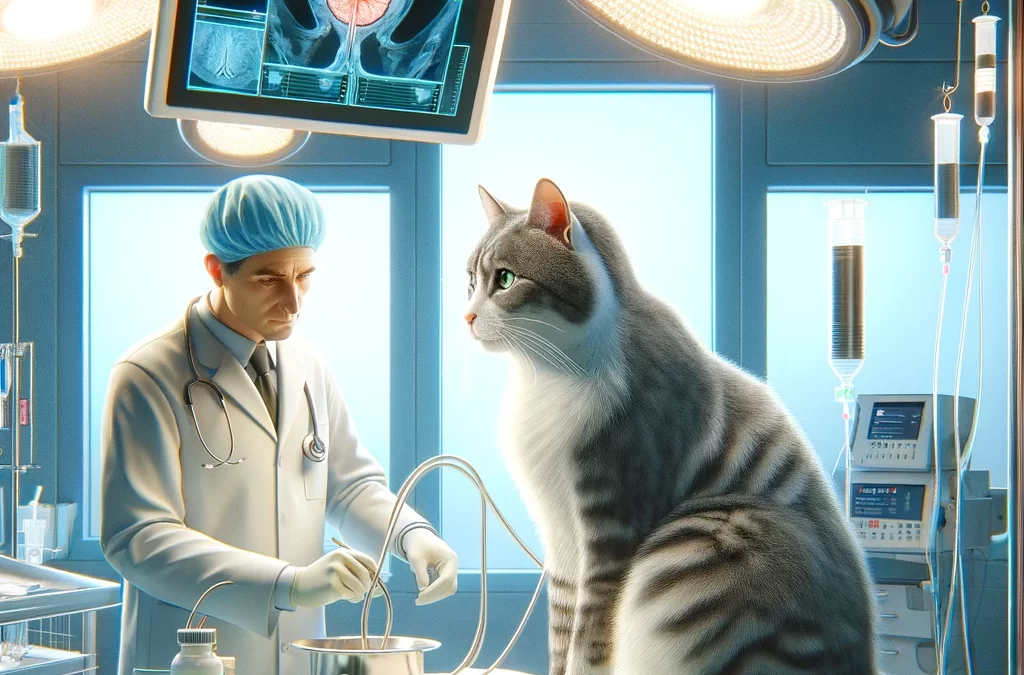
by TCMVET | Mar 12, 2024 | Cat Cancer & Tumors
Fibrosarcomas are among the more daunting diagnoses a cat owner can face. As a form of cancer that arises from fibrous tissue, these tumors pose a serious health threat. However, with advancements in veterinary medicine, there are several effective treatment options available. This article aims to provide an in-depth overview of these treatments, offering hope and guidance to cat owners.
Understanding Fibrosarcomas in Cats Fibrosarcomas are aggressive tumors that can occur in any part of a cat’s body but are commonly found in the skin and subcutaneous tissues. They are characterized by rapid growth and a high potential for recurrence and metastasis.
Surgical Removal The primary treatment for fibrosarcomas in cats is surgical removal of the tumor. The goal of surgery is to remove the entire tumor along with a margin of healthy tissue around it, to ensure no cancerous cells are left behind. The extent of the surgery depends on the tumor’s size and location.
Radiation Therapy Radiation therapy is often used in conjunction with surgery, especially if the tumor cannot be completely removed or if there’s a high risk of recurrence. It involves the use of high-energy rays to kill cancer cells. Radiation therapy is particularly useful for targeting specific areas and minimizing damage to surrounding healthy tissues.
Chemotherapy Chemotherapy is another option, especially in cases where the cancer has spread or there’s a significant risk of metastasis. Chemotherapy drugs can be administered orally or intravenously and work by targeting rapidly dividing cancer cells. The specific drugs and treatment regimen depend on the individual case.
Immunotherapy and Targeted Therapies Newer treatment options include immunotherapy and targeted therapies. These treatments focus on boosting the cat’s immune system to fight cancer or targeting specific molecules involved in tumor growth. While still relatively new, these therapies show promise for improving outcomes and reducing side effects.
Palliative Care In cases where curative treatment is not possible or if a cat is not a candidate for aggressive treatment, palliative care becomes the focus. This includes managing pain, ensuring proper nutrition, and maintaining quality of life.
Follow-Up and Monitoring Post-treatment, regular follow-up is crucial. This may involve physical examinations, imaging tests, and bloodwork to monitor for recurrence and manage any side effects of treatment.
The diagnosis of a fibrosarcoma in a cat can be challenging, but there are several treatment options available that offer hope. Advances in veterinary oncology continue to improve the prognosis for cats with this type of cancer. Early detection and prompt treatment are key to managing fibrosarcomas effectively.

by TCMVET | Mar 7, 2024 | Cat Cancer & Tumors
Squamous Cell Carcinoma (SCC) is a prevalent type of cancer in small animals, particularly affecting dogs and cats. It’s a malignant tumor that originates in the squamous epithelium, which is the outermost layer of the skin, as well as in the linings of the organs and cavities of the body. As a pet owner or a veterinary enthusiast, understanding the treatment options available for SCC in small animals is crucial for managing this disease effectively.
1. Surgical Removal:
Surgery is often the primary treatment for squamous cell carcinoma, particularly when the tumor is localized and has not metastasized. The goal of the surgery is to completely remove the cancerous tissue. In cases where SCC is located in the skin, the surgical removal is relatively straightforward. However, if the tumor is in more complex areas, such as the mouth or near the nail beds, the procedure can be more challenging. Post-surgical histopathology is essential to ensure that the margins are clear of cancer cells.
2. Radiation Therapy:
Radiation therapy is another effective treatment, particularly for tumors that are difficult to remove surgically, such as those in the oral cavity. It involves the use of high-energy rays to destroy cancer cells and shrink tumors. This therapy is often used post-surgery if the margins are not clear or if the cancer is inoperable. For some pets, radiation therapy can be used as a palliative treatment to relieve symptoms and improve the quality of life.
3. Chemotherapy:
Chemotherapy is less commonly used in treating SCC in small animals compared to other types of cancer, but it may be recommended in cases where the cancer has metastasized. It involves the use of drugs to kill cancer cells or slow their growth. Chemotherapy can be administered orally or through injections and often comes with side effects such as nausea, fatigue, and increased susceptibility to infections.
4. Cryosurgery:
For smaller or superficial SCC lesions, cryosurgery might be an option. This treatment involves using extreme cold (liquid nitrogen) to freeze and destroy abnormal cells. It is less invasive than traditional surgery and is usually performed on an outpatient basis.
5. Photodynamic Therapy (PDT):
PDT is a relatively new treatment option that involves using drugs, known as photosensitizing agents, alongside light to kill cancer cells. The drug is absorbed by the cancer cells and, when exposed to a specific wavelength of light, it produces a form of oxygen that kills the cells.
6. Electrochemotherapy:
Electrochemotherapy combines chemotherapy and electric pulses to enhance the absorption of chemotherapeutic drugs by the cancer cells. This treatment is gaining interest for treating tumors that are difficult to treat with conventional methods.
7. Palliative Care:
In cases where the cancer is too advanced, or the animal is not a good candidate for aggressive treatments, palliative care becomes the focus. This involves managing symptoms and maintaining the quality of life with medications, nutritional support, and pain management.
Treatment for squamous cell carcinoma in small animals varies based on the tumor’s location, size, and the general health of the animal. Advances in veterinary medicine have significantly increased the effectiveness of SCC treatments, offering hope and improved outcomes for pets diagnosed with this condition. Regular check-ups and early detection remain key in successfully managing and treating SCC. As always, consultation with a qualified veterinary oncologist is crucial to determine the best course of action for each individual case.






